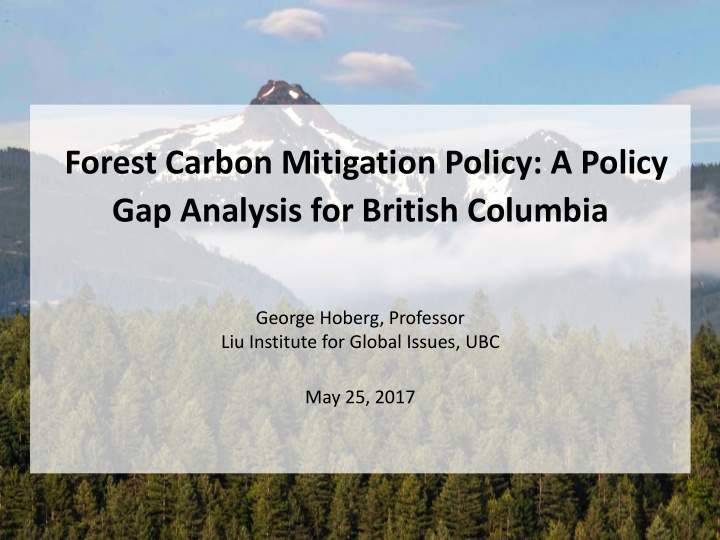



Forest Carbon Mitigation Policy: A Policy Gap Analysis for British Columbia George Hoberg, Professor Liu Institute for Global Issues, UBC May 25, 2017
Core policy choices 1. Change policies to require or incent GHG reduction 2. Directly fund programs or 3. Maintain status quo and rely on offsets
Forest carbon offsets • Carbon Neutral Government provides modest market for offsets Current • Greenhouse Gas Industrial Reporting and status Control Act and Regulation could establish larger market (awaiting FCOP) • Even when renewed offset market demand Gap limited • Expand demand for offsets by increasing eligible Options sources in BC or linking to other markets
Accounting • BC estimates and reports full forest sectors Current emissions, but only accounts for net status deforestation and 2 offset projects • Most anthropogenic forest sector Gap emissions/sinks not included in accounted • More fully incorporate forest emissions in provincial accounting to increase incentives to Options pursue cost-effective mitigation strategies across all of the province’s emission sources
Carbon tax Current • $30 per tonne on fuel combustion status • Gap Does not cover forest emissions • Options Apply carbon tax to slash burning
Tenure • Virtually all tenure types only give rights to timber Current • Community Forest, First Nations tenures: status “ botanical forest products and other prescribed products ” • Tenure holders do not have the right to manage Gap for carbon unless covered by Atmospheric Benefit Agreement • Options Give tenure holder rights to manage for carbon
Atmospheric benefit agreements • 3 First Nations agreements Current • 2014 – ABA’s allowed for non -FNs: Cheakamus status Community Forest • Gap only a small fraction of province covered • Options expand area of forest covered
Forest & Range Practices Act Current • FRPA has 11 values, but not carbon status • Gap Carbon not a value to be managed under FRPA • Amend FRPA to include carbon Options - It would also have to be considered in AAC - Could also include it in Land Use Orders
Fire management • Current Wildfire Act requires managing fire risks - Leads status to common practice of slash burning • Current wildfire policies do not consider or Gap incorporate managing forestland for carbon • Encourage or require greater consideration of Options carbon in fire management
Increase wood use and longer-lived wood products • Wood First Act promotes would use in Current government-funded buildings; changes to building status code to allow taller wood buildings • Limited leverage over private sector decision- Gap making • Options A more directive approach
Bioenergy • Current Modest policies to encourage wood bioenergy status use, including 2 secondary tenures applied • Gap Limited direction provided in policy • Provide financial incentives or regulatory Options requirements for forest bioenergy use where it contributes to GHG emission reductions
Direct government funding • Announcement of Forest Carbon Initiative in Current Climate Leadership Plan; $150 million commitment status to Forest Enhancement Society of BC • No existing funding or operational plan to Gap perform rehabilitation sufficient to meet 12 MT target by 2050 • Development and implementation of rigorous Options operational plan with sufficient funding
Policy gaps - Conclusions • Some management emissions still not accounted 1. Climate policies • Not covered by carbon tax have only modest • Eligible for CNG and GGIRCA offsets coverage of forests • ABAs cover only small area of province • No tenure rights 2. Forest policies • Not considered in AAC generally ignore • Not a FRPA value carbon • Not addressed in fire 3. Promoting wood use limited 4. Bioenergy policy limited
Next steps 1. Stakeholder input 2. Develop refined policies and apply evaluative criteria or e.g., Effectiveness in reducing forest sector GHGs Cost-effectiveness Administrative feasibility Political feasibility
Thank you! George Hoberg, Professor Liu Institute for Global Issues, UBC george.hoberg@ubc.ca
Recommend
More recommend